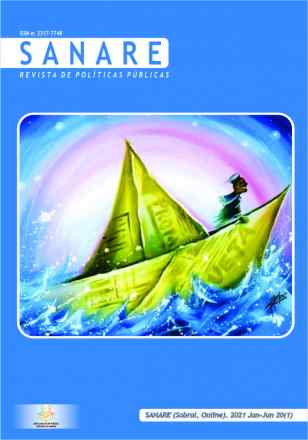DISFUNÇÃO TEMPOROMANDIBULAR: A AVALIAÇÃO FISIOTERAPÊUTICA EM DISCENTES DE UMA INSTITUIÇÃO DE ENSINO SUPERIOR DO MUNICÍPIO DE SOBRAL-CEARÁ
SANARE - Revista de Políticas Públicas
DISFUNÇÃO TEMPOROMANDIBULAR: A AVALIAÇÃO FISIOTERAPÊUTICA EM DISCENTES DE UMA INSTITUIÇÃO DE ENSINO SUPERIOR DO MUNICÍPIO DE SOBRAL-CEARÁ
Autor Correspondente: I. A. Parente | [email protected]
Palavras-chave: Articulação Temporomandibular, Dor Orofacial, Fisioterapia.
Resumos Cadastrados
Resumo Português:
O estudo avaliou a disfunção temporomandibular em discentes do 3º semestre de um curso da área da saúde de uma faculdade
privada de Sobral, Ceará, através da avaliação fisioterapêutica, traçando o perfil socioeconômico, classificando a DTM
quanto à sua severidade para assim conhecer as limitações funcionais dos participantes. Tratou-se de uma pesquisa exploratória,
descritiva e quantitativa, realizada no período de maio a agosto de 2013, com amostragem de 80 participantes. Foram utilizados
duas fichas de avaliação para coleta dos dados: Índice de Disfunção Clínica Craniomandibular (IDCCM) com Índice de Mobilidade
Mandibular e o Questionário e Índice de Limitação Funcional Mandibular, que foram analisados pelo Programa Microsoft Excel
2007. 82% eram do sexo feminino com idade média de 21 anos, sendo 83% solteiros, 42% naturalizados de Sobral e 59%
não apresenta nenhuma disfunção. Com relação aos participantes que apresentaram alguma limitação funcional, 96% foram
classificados com grau de severidade baixo. Observa-se uma prevalência no sexo feminino, porém a sintomatologia foi referida em
baixa intensidade, podendo levar ao diagnóstico de DTM suave.
Resumo Inglês:
T he study assessed temporomandibular joint dysfunction (TMD) in students from the 3rd semester of a course in the area of health from a private faculty in Sobral, Ceará, by means of physiotherapeutic assessment, outlining socioeconomic profile, classifying the severity of TMD, thereby getting to know the functional limitations of the participants. This was an explorative, descriptive and quantitative study, conducted in the May to August 2013 period, with a sample of 80 participants. Two assessment records were used for data collection: Index of Clinical Craniomandibular Dysfunction (ICCMD) with Index of Mandibular Mobility and the Questionnaire and Index of Mandibular Functional Limitation, which were analyzed using the Microsoft Excel 2007 Program. Eighty-two percent were female with a mean age of 21 years, 83% were unmarried, 42% were from Sobral and 59% did not present any dysfunction. Regarding the participants who presented some functional limitation, 96% were classified with a low degree of severity. Higher prevalence was observed in females; however symptomatology was referred to in low intensity, leading to the diagnosis of mild TMD.

